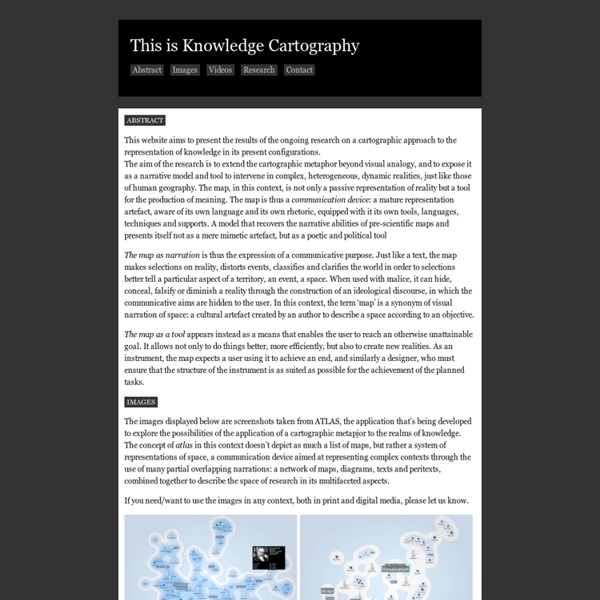» Beyond Tag Clouds: TagArcs for Wordpress Tag Visualization (part I)
Beyond Tag Clouds: TagArcs for WordPress Tag Visualization Tag clouds are very useful to visualize the most frequently used tags on a website, e.g. a blog. This is done by steering attention through emphasized words whose font size, color or position stands out. But nothing can be found out about temporal relation of a tag's posts. For me this became evidently on my own tag cloud (see left) which still rates 'Lima' at the leading position whereas the related articles are more then three years old.
All projects
GEO Editor Online half-edge mesh platonic solids editor Underwater Online Text Deformation Tool
Glacier Bay National Park and Preserve - Mapping Coastal Resources at Glacier Bay
Introduction The 1989 Exxon Valdez oil spill (EVOS) demonstrated that accurate baseline information about existing coastal resources is crucial to managing the response, cleanup, and restoration of a major environmental disaster. One of the most important lessons that emerged from the EVOS experience is that an ongoing resources inventory and monitoring program is an absolute necessity for preparing ourselves for such "unscheduled events" as well as for general resource protection. Other activities taking place in coastal areas may also have effects on the environment that are less spectacular than a major spill but just as profound in the long run. Managers must understand what resources exist in a given area as well as their ranges of natural variation (both spatial and temporal) if they are to protect them from human-caused change.
ImagePlot visualization software: explore patterns in large image collections
What is ImagePlot? ImagePlot is a free software tool that visualizes collections of images and video of any size. It is implemented as a macro which works with the open source image processing program ImageJ. ImagePlot was developed by the Software Studies Initiative with support from the National Endowment for Humanities (NEH), the California Institute for Telecommunications and Information Technology (Calit2), and the Center for Research in Computing and the Arts (CRCA). See your whole image collection in a single visualization. Existing visualization tools show data as points, lines, and bars.
Data Visualization
Katharine Morgan Tech blogs. They don’t agree on much. Apple Fanboys, Android Fanboys, Playstation Fanboys, Xbox Fanboys… the web is awash with people flaming each other about their choice of technology. If there’s one thing they do agree on however it’s that the time of Internet Explorer is over. Hail the King.
Cartography
Cartography (from Greek χάρτης khartēs, "map"; and γράφειν graphein, "write") is the study and practice of making maps. Combining science, aesthetics, and technique, cartography builds on the premise that reality can be modeled in ways that communicate spatial information effectively. The fundamental problems of traditional cartography are to:[citation needed] Set the map's agenda and select traits of the object to be mapped. This is the concern of map editing.
38 Tools For Beautiful Data Visualisations
As we enter the Big Data era, it becomes more important to properly expand our capacity to process information for analysis and communication purposes. In a business context, this is evident as good visualisation techniques can support statistical treatment of data, or even become an analysis technique. But also, can be used as a communication tool to report insights that inform decisions.
Digital World Tectonic Activity Map (DTAM)
The Digital Tectonic Activity Map (DTAM) is a new visualization tool for both researcher and educator alike to better understand tectonic activity of our planet for the past 1 million years. DTAM is a Geographical Information System (GIS) that displays a realistic synoptic view of present global tectonism by filling in the cartographic gap between conventional geological maps and plate reconstruction maps. The DTAM was created using current global datasets of seismicity, volcanism, and plate motions that were integrated with topography and bathymetry measurements derived from satellite gravity data. Macroscopic structural features were integrated via field studies from various researchers, space geodesy, and space-borne imagery (e.g. astronaut photography, Landsat). This integrative technique provides a new and unique visualization tool that presents an actual representational view of global tectonics rather than the traditional schematic illustrations (i.e. plate maps) of the past.
mkweb.bcgsc.ca/schemaball/?home
Schemaball is a flexible schema visualizer for SQL databases. The purpose of Schemaball is to help visualize the relationships between tables. Tables are related by foreign keys, which are fields which store the value of a record field from another table.



